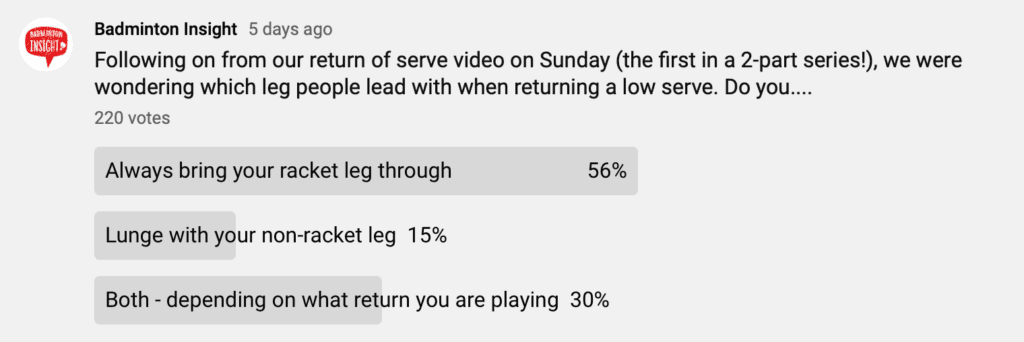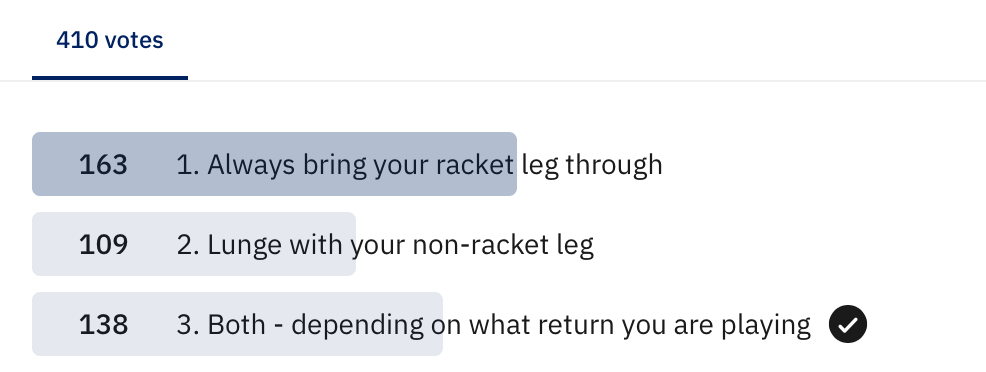Which Leg Should You Lead With On The Return Of Serve In Doubles?
We asked our audience on YouTube and Reddit: Which leg should you lead with when returning the serve in badminton?
When returning the serve in doubles, you can lead with your racket leg, your non-racket leg, or both of these. It will depend on the shot you are playing, where your opponent serves to, and what event you are playing.
It was a very close poll on both platforms and provides an interesting debate which we want to discuss further!


When waiting to receive the serve in doubles you should have your non-racket leg in front of you and when returning the serve you can lead with either leg. This depends on what shot you are playing, where your opponent serves to and what event you are playing.
Let us explain…
When To Lead With Your Racket Leg
If you are playing a really aggressive shot and fully committing to the return then you should bring your racket leg through. This will usually help you to play a better shot, however, occasionally if the return comes back then you may not be in an optimal position for the next shot.
If your opponent serves low out wide then you should bring your racket leg through. if you don’t you will not be able to take the shuttle early or perhaps even reach the shuttle. If your opponents serve to the T you may need to move a little bit more to take the shuttle early, so may have to bring your racket leg through. This will of course depend on things such as your height and athletic ability!
If you are right handed and return a serve to the T from the right box hard down the line, with your racket leg coming through, then you may have enough time before your opponent hits the shot to recover and be ready for the reply down your side. Similarly, if you bring your racket leg through and play a net shot your momentum will leave you ready to cover the net.
When To Lead With Your Non-Racket Leg
If you are playing a less aggressive and committed return, or need to be in a good position for the next shot it may be better to lead with your non-racket leg.
Leading with the non-racket leg is more common for the man in mixed doubles as they are able to quickly move to cover other areas of the court after the return. Most male mixed players return in this way, Zheng Siwei, Praveen Jordan and Chris Adcock are just a few examples.
If your opponent serves into your body and you want to play a flat return then this is where it may be a good option to quickly lead with your non-racket leg. You will therefore find yourself in a better position for the next shot. You can however still be in a good position when bringing your racket leg through, this depends on the shot you have played and also if you are planning a ‘set play’ with your partner…
Set Plays
A lot of advanced partnerships will have set plays they like to do to try to win a quick point or gain an initiative in the first 3 shots. A common one is to play a hard shot down the middle to the servers partner and then take a side of the court each, expecting a hard shot in reply. When doing this it is usually best to lead with your non-racket leg so that you can recover into this position quicker!
There are lots more set plays which can be adopted by men’s doubles, mixed doubles and women’s doubles pairs and these all involve playing a certain return hoping that your opponents play a certain shot in response to it.
An example of this is a set play made famous by Boe and Mogensen. This involves the returner returning straight down the line and then moving to cover the cross court shot whilst their partner comes round onto their forehand side to take the straight reply (the likely reply). To do this return you can lead with either leg as long as you are ready to cover the cross court shot if it comes. Mathias Boe always lead with his non-racket leg when playing this shot.
We covered this set play in a YouTube video on advanced return of serves if you want to have a watch:
To conclude, the leg you lead with on your return of serve will depend on what shot you are playing and where you are likely to move after, where your opponent serves to and what event you are playing. Many players will have a favourite type of return and a favoured leg they choose to lead with on returns.
This may be formed as a result of trial and error over the years, or may have been the only ever way you tried. We encourage you to think about what we have discussed in this post and experiment to find what suits you best.
If you have anything to add to this debate, please leave a comment in the comments section below!

